Effect of Airflow Non-Uniformities on the Thermal Performance of Water–Air Heat Exchangers—Experimental Study and Analysis
Abstract
1. Introduction
- Development of experimental measurement techniques appropriate for underhood experimental analysis;
- Physical analysis of heat transfer phenomena occurring in the zone engine/components and development of associated analytical and semi-analytical models;
- Analysis and thermal modeling of the zone comprising the heat exchangers.
2. Theoretical Background
- Hot water inlet flow is uniformly distributed among the columns of the discretized HX surface.
- Perfect mixing is assumed at the outlet of the columns.
- The temperature at the outlet of each cell is considered as the inlet temperature of the neighboring cell.
- The method of obtaining an overall heat transfer coefficient of the entire HX is valid on each cell in the HX matrix.
3. Experimental Setup
3.1. The Thermal Part
3.2. The Aerodynamic Part
- An air duct (70 cm × 60 cm) is discretized into 15 smaller areas (cells). Accordingly, each small area consists of 18.3 × 14 cm2. Accordingly, this division allows controlling the airflow in each cell to have the desired configuration of non-uniformity. The reasoning behind this discretization is to be in accordance with the numerical methods that are based on the same principle.
- Fifteen 100 W fans, capable of providing an air velocity up to 13 m·s−1 through each cell (discretized duct).
- Speed regulators to control the speed of the fans is used in order to create the velocity maldistribution configuration through the discretized duct.
- 40-A/12-V batteries to power up the fans and their regulators.
3.3. Measurements and Uncertainty
4. Testing Configuration and Results
- Fix a certain water flow rate and mean airflow velocity;
- Try all the non-uniformity configurations at the prescribed mean air velocity;
- Record the inlet and outlet temperatures at each configuration.
5. Discussion
6. Conclusions
Author Contributions
Funding
Data Availability Statement
Conflicts of Interest
Nomenclature
| a | constant |
| A | surface area (m2) |
| b | constant |
| heat capacity (J kg−1 K−1) | |
| ETD | extreme temperature difference (°C) |
| HX | heat exchanger |
| m | number of column of heat exchanger matrix |
| flow rate (kg s−1) | |
| n | number of rows of heat exchanger matrix |
| N | number of cells of heat exchanger matrix |
| Q | water flowrate (L h−1) |
| heat exchanger thermal performance (kW) | |
| heat exchanger performance for a uniform airflow (kW) | |
| T | temperature (°C) |
| U | overall heat transfer coefficient (W m−2 K−1) |
| V | airflow velocity (m/s) |
| standard deviation of velocity distribution (m/s) | |
| Subscripts | |
| air | air |
| cell | cell |
| fluid | fluid |
| in | inlet |
| m | mean |
| out | outlet |
| w | water |
References
- Khaled, M.; Harambat, F.; El Hage, H.; Peerhossaini, H. Spatial optimization of underhood cooling module—Towards an innovative control approach. Appl. Energy 2011, 88, 3841–3849. [Google Scholar] [CrossRef]
- Karamanos, K.; Afrasiabian, E.; In Kim, S.; Dougla, R.; Mahmoudi, Y. Multifidelity simulation of underhood thermal system for a bus engine. Appl. Therm. Eng. 2022, 201, 117707. [Google Scholar] [CrossRef]
- Lu, P.; Gao, Q.; Wang, Y. The simulation methods based on 1D/3D collaborative computing for the vehicle integrated thermal management. Appl. Therm. Eng. 2016, 104, 42–53. [Google Scholar] [CrossRef]
- Liu, X.; Guo, H.; Cheng, X.; Du, J.; Ma, J. A Robust Design of the Model-Free-Adaptive-Control-Based Energy Management for Plug-in Hybrid Electric Vehicle. Energies 2022, 15, 7467. [Google Scholar] [CrossRef]
- Khaled, M.; Garnier, B.; Harambat, F.; Peerhossaini, H. A New Method for Simultaneous Measurement of Convective and Radiative Heat Flux in Car Underhood Applications. Meas. Sci. Technol. 2010, 21, 025903. [Google Scholar] [CrossRef]
- Mancaruso, E.; Sequino, L. Measurements and modeling of piston temperature in a research compression ignition engine during transient conditions. Results Eng. 2019, 2, 100007. [Google Scholar] [CrossRef]
- Lyu, Y.; Siddique, A.R.M.; Gadsden, S.A.; Mahmud, S. Experimental investigation of thermoelectric cooling for a new battery pack design in a copper holder. Results Eng. 2021, 10, 100214. [Google Scholar] [CrossRef]
- Zhang, L.; Zhai, H.; He, J.; Yang, F.; Wang, S. Application of Exergy Analysis in Flue Gas Condensation Waste Heat Recovery System Evaluation. Energies 2022, 15, 7525. [Google Scholar] [CrossRef]
- Ameur, H. Effect of the baffle inclination on the flow and thermal fields in channel heat exchangers. Results Eng. 2019, 3, 100021. [Google Scholar] [CrossRef]
- Seco-Nicolás, M.; García, M.A.; Luna-Abad, J.P. Experimental calculation of the mean temperature of flat plate thermal solar collectors. Results Eng. 2020, 5, 100095. [Google Scholar] [CrossRef]
- Hussein, A.M.; Dawood, H.K.; Bakara, R.A.; Kadirgamaa, K. Numerical study on turbulent forced convective heat transfer using nanofluids TiO2 in an automotive cooling system. Case Stud. Therm. Eng. 2017, 9, 72–78. [Google Scholar] [CrossRef]
- Lee, Y.T.; Chien, L.H.; He, J.; Wen, C.Y.; Yang, A.S. Air side performance characterization of wavy Fin-and-tube heat exchangers having elliptic tubes with large waffle heights. Appl. Therm. Eng. 2022, 217, 119220. [Google Scholar] [CrossRef]
- Zhang, L.; Song, M.; Mao, N.; Dong, J. Temporal and spatial frost growth prediction of a tube-finned heat exchanger considering frost distribution characteristics. Int. J. Heat Mass Transf. 2022, 183, 122192. [Google Scholar] [CrossRef]
- Blecich, P. Experimental investigation of the effects of airflow nonuniformity on performance of a fin-and-tube heat exchanger. Int. J. Refrig. 2015, 59, 65–74. [Google Scholar] [CrossRef]
- Fernández-Seara, J.; Pardiñas, Á.Á.; Diz, R. Heat transfer enhancement of ammonia pool boiling with an integral-fin tube. Int. J. Refrig. 2016, 69, 175–185. [Google Scholar] [CrossRef]
- Abdous, M.A.; Saffari, H.; Avval, H.B.; Khoshzat, M. The study of entropy generation during flow boiling in a micro-fin tube. Int. J. Refrig. 2016, 68, 76–93. [Google Scholar] [CrossRef]
- Waschle, A. Numerical methods, Three-Dimensional. In Progress in Vehicle Aerodynamics II Thermo-Management; Wiedemann, J., Hucho, W.H., Eds.; Expert: Stuttgart, Germany, 2002; pp. 115–128. [Google Scholar]
- Zhang, L.Z. Flow maldistribution and thermal performance deterioration in a cross-flow air to air heat exchanger with plate-fin cores. Int. J. Heat Mass Transf. 2009, 52, 4500–4509. [Google Scholar] [CrossRef]
- Shaji, K.; Das, S.K. The effect of flow maldistribution on the evaluation of axial dispersion and thermal performance during the single-blow testing of plate heat exchangers. Int. J. Heat Mass Transf. 2010, 53, 1591–1602. [Google Scholar] [CrossRef]
- Srihari, N.; Rao, B.P.; Sunden, B.; Das, S.K. Transient response of plate heat exchangers considering effect of flow maldistribution. Int. J. Heat Mass Transf. 2005, 48, 3231–3243. [Google Scholar] [CrossRef]
- Cabezas-Gómez, L.; Navarro, H.A.; de Godoy, S.M.; Campo, A.; Saiz-Jabardo, J.M. Thermal characterization of a cross-flow heat exchanger with a new flow arrangement. Int. J. Therm. Sci. 2009, 48, 2165–2170. [Google Scholar] [CrossRef]
- Khaled, M.; El Hage, H.; El Marakbi, A.; Harambat, F.; Peerhossaini, H. Aerothermal management of vehicle heat exchangers—Parametric analysis. In Fluids Engineering Division Summer Conference; American Society of Mechanical Engineers: Reno, NV, USA, 2013. [Google Scholar] [CrossRef]
- Khaled, M.; Harambat, F.; Peerhossaini, H. Analytical and empirical determination of thermal performance of louvered heat exchanger–effects of air flow statistics. Int. J. Heat Mass Transf. 2011, 54, 356–365. [Google Scholar] [CrossRef]
- Khaled, M.; Ramadan, M.; Shaito, A.; El Hage, H.; Harambat, F.; Peerhossaini, H. Parametric analysis of heat exchanger thermal performance in complex geometries—Effect of air velocity and water flow distributions. Heat Transf. Eng. 2016, 37, 1027–1037. [Google Scholar] [CrossRef]
- Song, X.; Huang, D.; Liu, X.; Chen, Q. Effect of non-uniform air velocity distribution on evaporator performance and its improvement on a residential air conditioner. Appl. Therm. Eng. 2012, 40, 284–293. [Google Scholar] [CrossRef]
- Beiler, M.G.; Kröger, D.G. Thermal performance reduction in air-cooled heat exchangers due to nonuniform flow and temperature distributions. Heat Transf. Eng. 1996, 17, 82–92. [Google Scholar] [CrossRef]
- Zhao, L.; Wang, B.; Wang, J.; Zhu, Z.; Li, T.; Guo, B.; Yang, Z. Effect of non-uniform airflow on the performance of a parallel-flow heat exchanger considering internal fluid distribution—Simulation studies and its experimental validation. Appl. Therm. Eng. 2020, 180, 115685. [Google Scholar] [CrossRef]
- T’joen, C.; Willockx, A.; Steeman, H.J.; De Paepe, M. Performance prediction of compact fin-and-tube heat exchangers in maldistributed airflow. Heat Transf. Eng. 2007, 28, 986–996. [Google Scholar] [CrossRef]
- Mueller, A.C. Effects of some types of maldistribution on the performance of heat exchangers. Heat Transf. Eng. 1987, 8, 75–86. [Google Scholar] [CrossRef]
- Mao, J.N.; Chen, H.X.; Jia, H.; Wang, Y.Z.; Hu, H.M. Effect of air-side flow maldistribution on thermal–hydraulic performance of the multi-louvered fin and tube heat exchanger. Int. J. Therm. Sci. 2013, 73, 46–57. [Google Scholar] [CrossRef]
- Yaïci, W.; Ghorab, M.; Entchev, E. 3D CFD analysis of the effect of inlet air flow maldistribution on the fluid flow and heat transfer performances of plate-fin-and-tube laminar heat exchangers. Int. J. Heat Mass Transf. 2014, 74, 490–500. [Google Scholar] [CrossRef]
- Kou, H.S.; Yuan, P. Thermal performance of crossflow heat exchanger with nonuniform inlet temperatures. Int. Commun. Heat Mass Transf. 1997, 24, 357–370. [Google Scholar] [CrossRef]
- Guo, Z.Y.; Zhou, S.Q.; Li, Z.X.; Chen, L.G. Theoretical analysis and experimental confirmation of the uniformity principle of temperature difference field in heat exchanger. Int. J. Heat Mass Transf. 2002, 45, 2119–2127. [Google Scholar] [CrossRef]
- Mishra, M.; Das, P.K.; Sarangi, S. Effect of temperature and flow nonuniformity on transient behaviour of crossflow heat exchanger. Int. J. Heat Mass Transf. 2008, 51, 2583–2592. [Google Scholar] [CrossRef]
- Zhu, A.; Ali, H.; Ishaq, M.; Junaid, M.S.; Raza, J.; Amjad, M. Numerical Study of Heat and Mass Transfer for Williamson Nanofluid over Stretching/Shrinking Sheet along with Brownian and Thermophoresis Effects. Energies 2022, 15, 5926. [Google Scholar] [CrossRef]
- Ishaq, M.; Ali, A.; Amjad, M.; Syed, K.S.; Iqbal, Z. Diamond-Shaped Extended Fins for Heat Transfer Enhancement in a Double-Pipe Heat Exchanger: An Innovative Design. Appl. Sci. 2022, 11, 5954. [Google Scholar] [CrossRef]
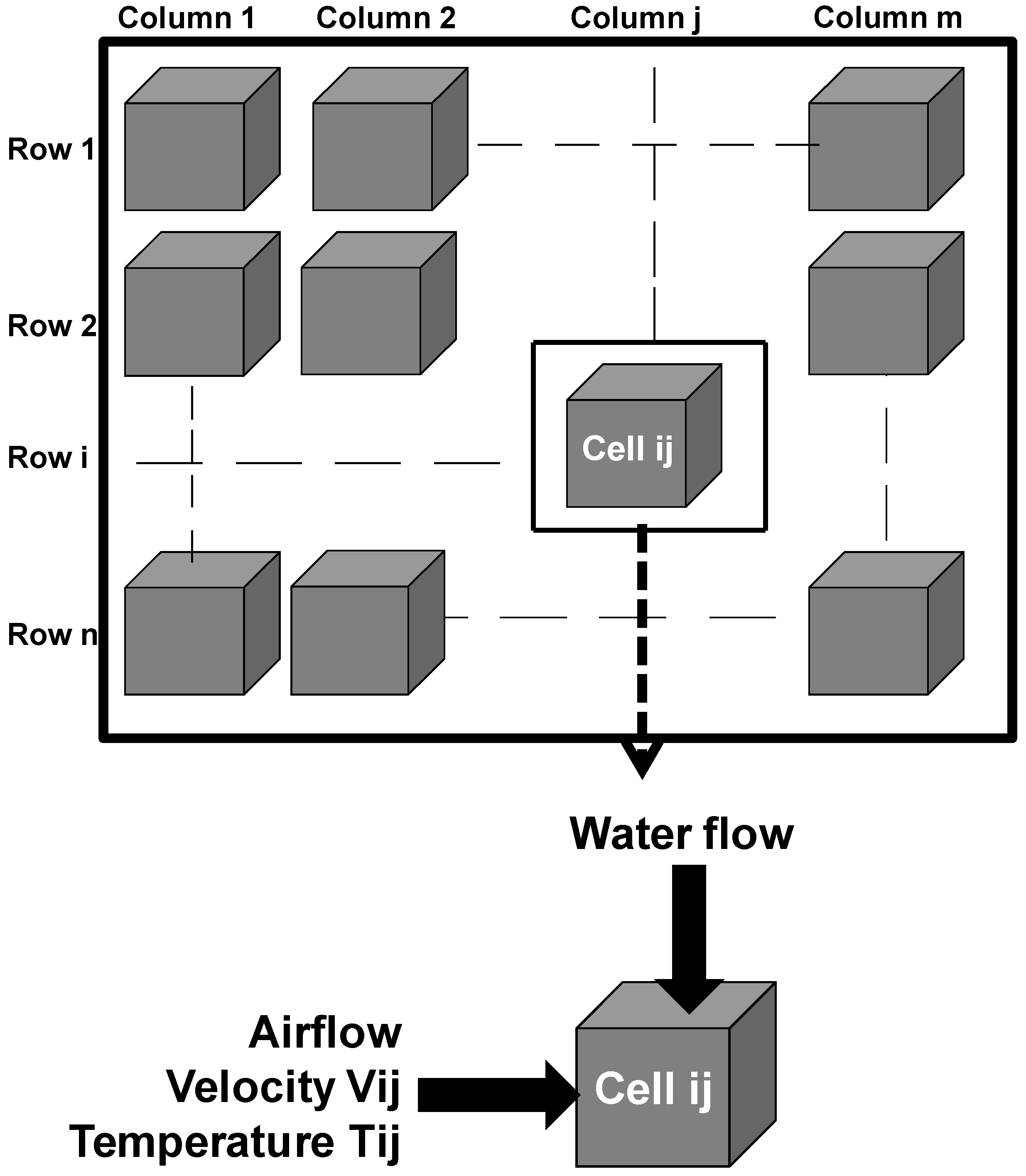

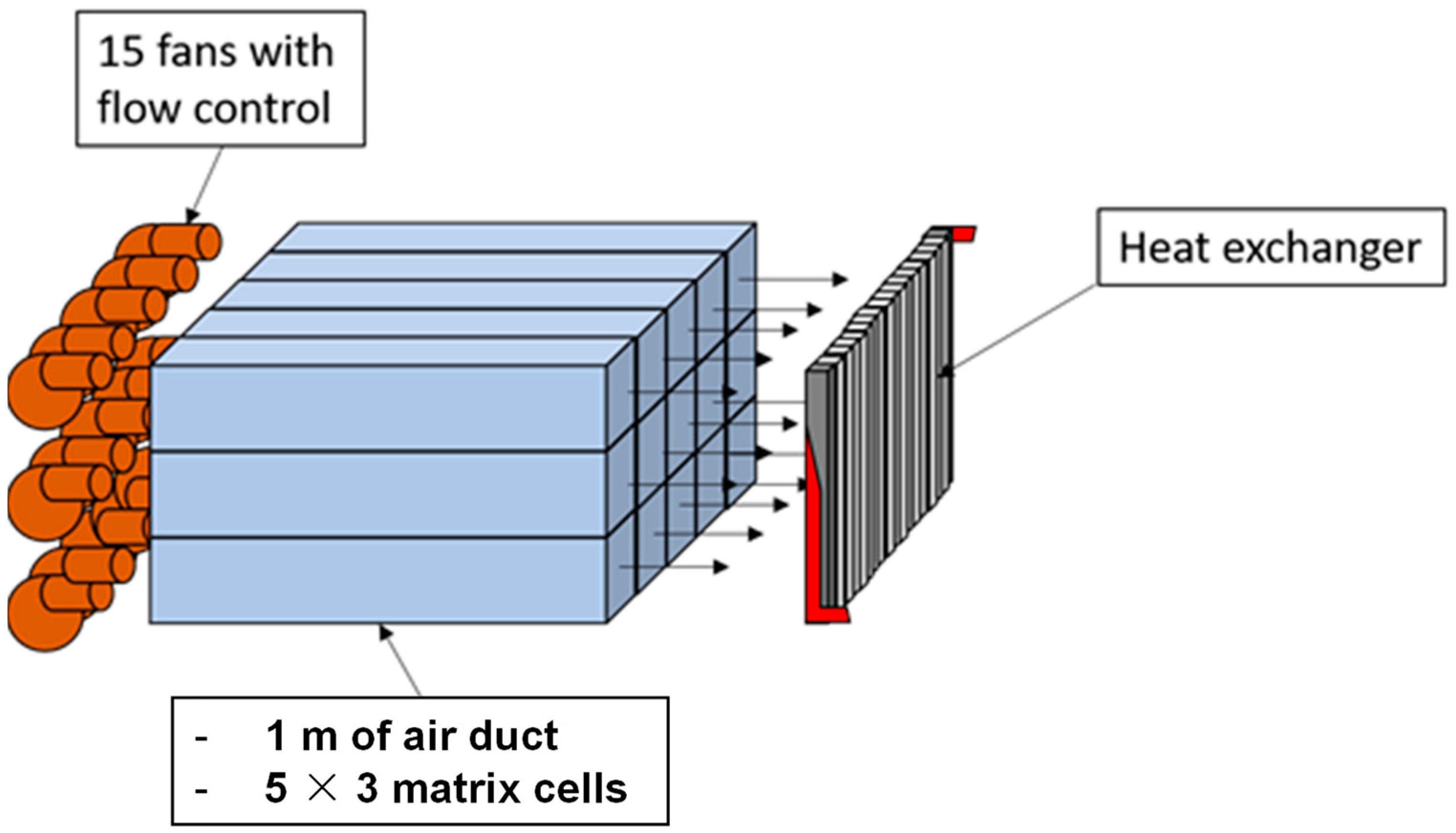
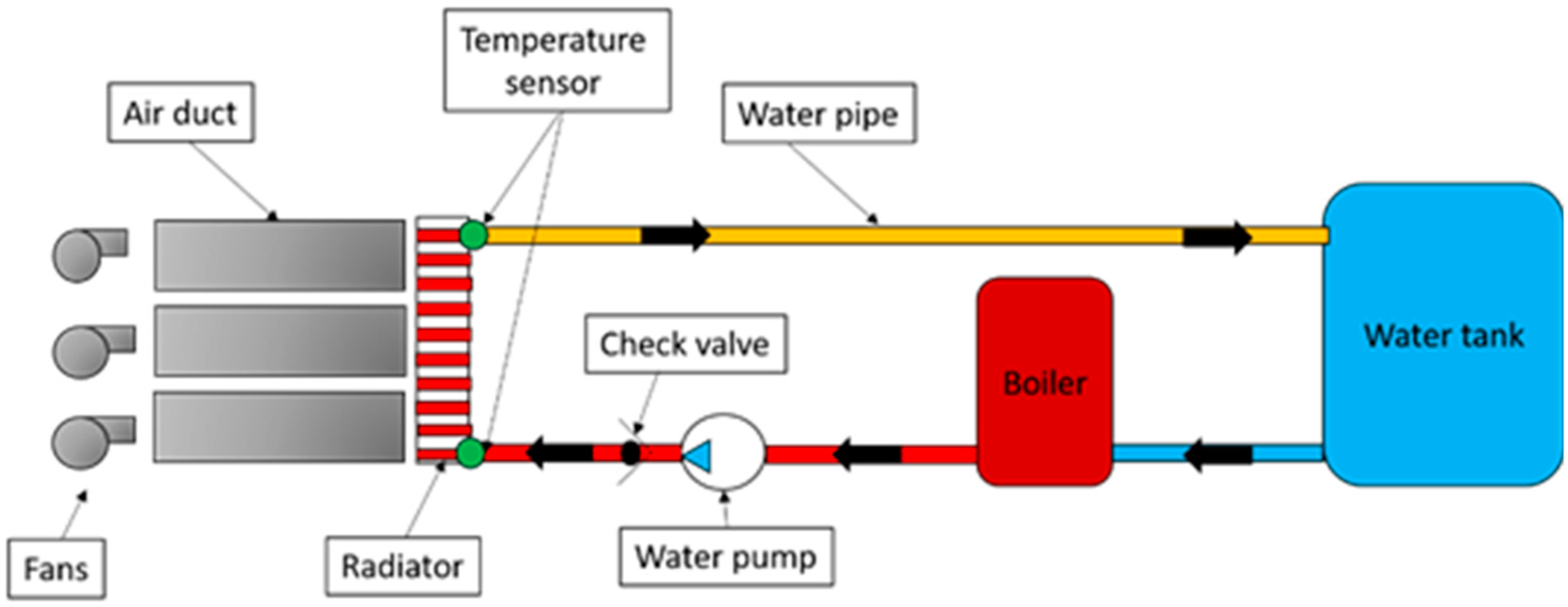
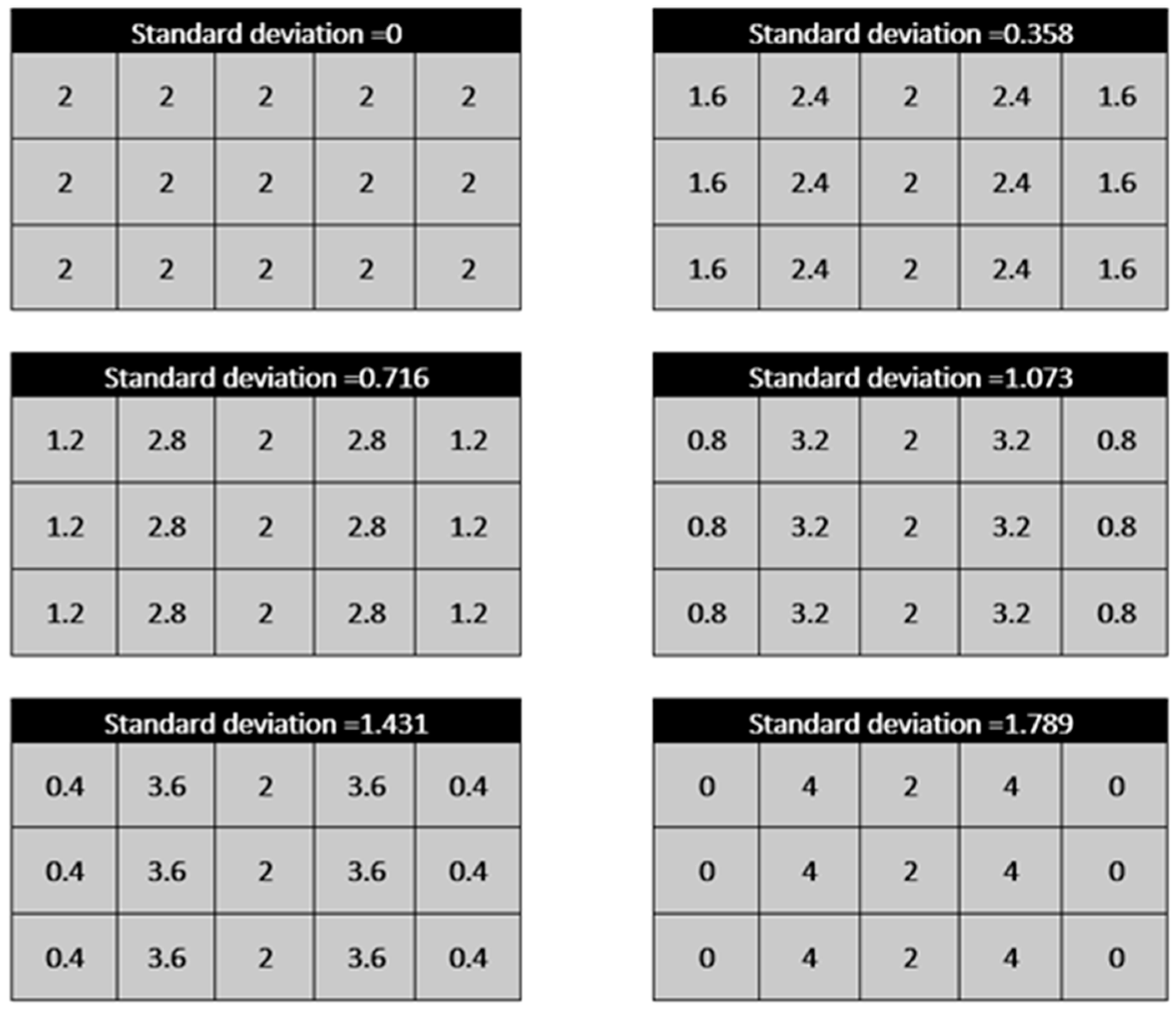
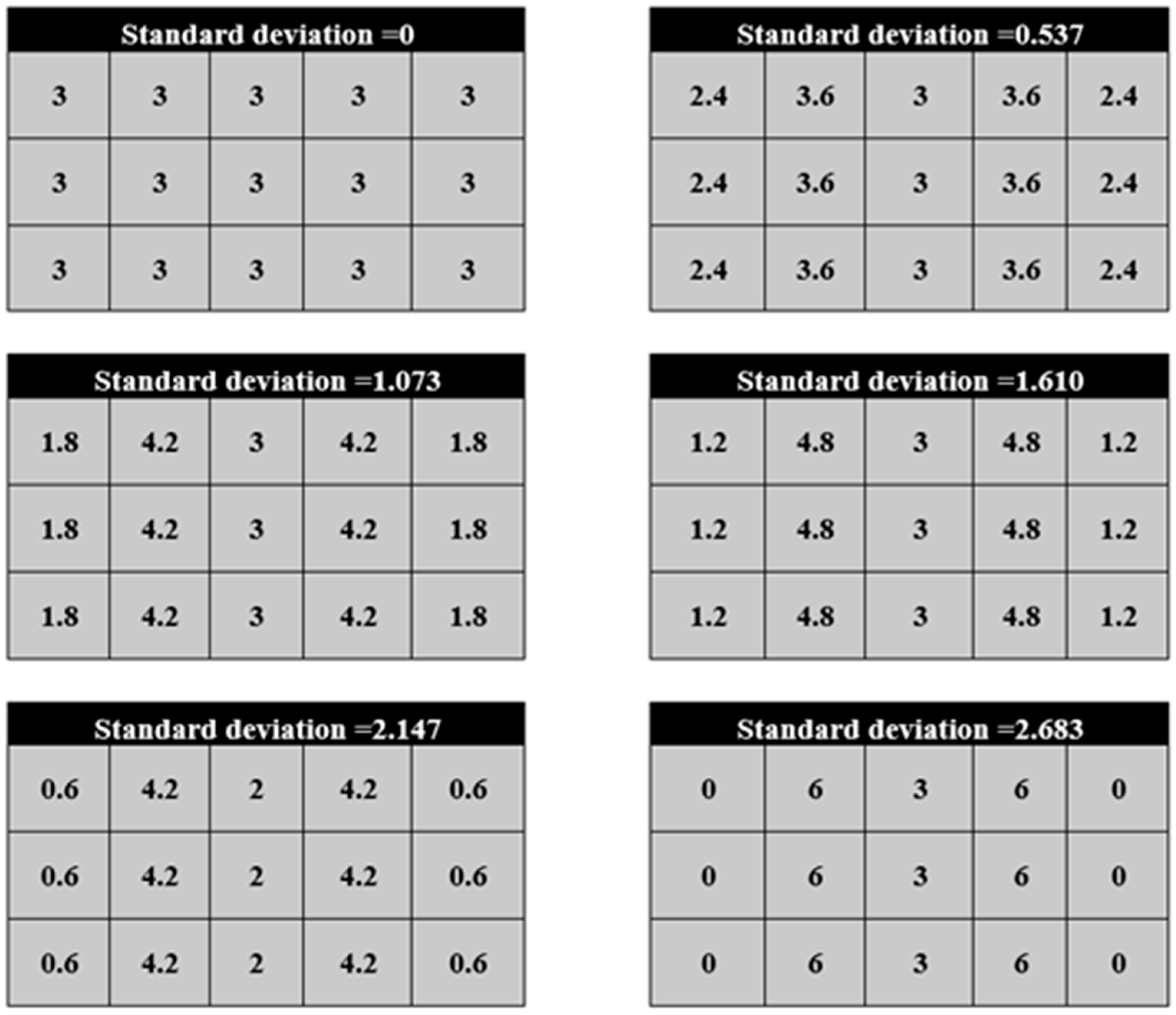


| Component | Description |
|---|---|
| Water tank | A 100 L capacity tank that supplies water to the heater. A gate valve is incorporated |
| Electric heater | A 100 L capacity heater, responsible for heating the water to the desired temperature. Equipped with valves for the control of the flow rate. (Figure 2) |
| Hot water pump | Characterized with a 10 m maximum head, 18 L·min−1 volume flow rate and 2900 rpm. Responsible for circulating the hot water in the heat exchanger. (Figure 2) |
| Radiator | HX surface of 70 × 55 cm2, with temperature sensors at the inlet and outlet. (Figure 2) |
| Water Temperature Reduction% | HX Performance Deterioration% (Relative to Stdev = 0 m/s Case) | |||
|---|---|---|---|---|
| Standard Deviation (m/s) | Study Results | Literature [22] | Study Results | Literature [22] |
| 0 | 9.24 | 8.7 | 0 | 0 |
| 0.5 | 7.09 | 6.9 | 9.35 | 8.6 |
| 1 | 6.17 | 5.22 | 14.02 | 13.33 |
| 1.5 | 3.83 | 3.89 | 20.56 | 21.9 |
| 2 | 2.5 | 2.9 | 25.24 | 26.8 |
Publisher’s Note: MDPI stays neutral with regard to jurisdictional claims in published maps and institutional affiliations. |
© 2022 by the authors. Licensee MDPI, Basel, Switzerland. This article is an open access article distributed under the terms and conditions of the Creative Commons Attribution (CC BY) license (https://creativecommons.org/licenses/by/4.0/).
Share and Cite
Khaled, M.; Mortada, M.; Faraj, J.; Chahine, K.; Lemenand, T.; Ramadan, H.S. Effect of Airflow Non-Uniformities on the Thermal Performance of Water–Air Heat Exchangers—Experimental Study and Analysis. Energies 2022, 15, 8120. https://doi.org/10.3390/en15218120
Khaled M, Mortada M, Faraj J, Chahine K, Lemenand T, Ramadan HS. Effect of Airflow Non-Uniformities on the Thermal Performance of Water–Air Heat Exchangers—Experimental Study and Analysis. Energies. 2022; 15(21):8120. https://doi.org/10.3390/en15218120
Chicago/Turabian StyleKhaled, Mahmoud, Mostafa Mortada, Jalal Faraj, Khaled Chahine, Thierry Lemenand, and Haitham S. Ramadan. 2022. "Effect of Airflow Non-Uniformities on the Thermal Performance of Water–Air Heat Exchangers—Experimental Study and Analysis" Energies 15, no. 21: 8120. https://doi.org/10.3390/en15218120
APA StyleKhaled, M., Mortada, M., Faraj, J., Chahine, K., Lemenand, T., & Ramadan, H. S. (2022). Effect of Airflow Non-Uniformities on the Thermal Performance of Water–Air Heat Exchangers—Experimental Study and Analysis. Energies, 15(21), 8120. https://doi.org/10.3390/en15218120






